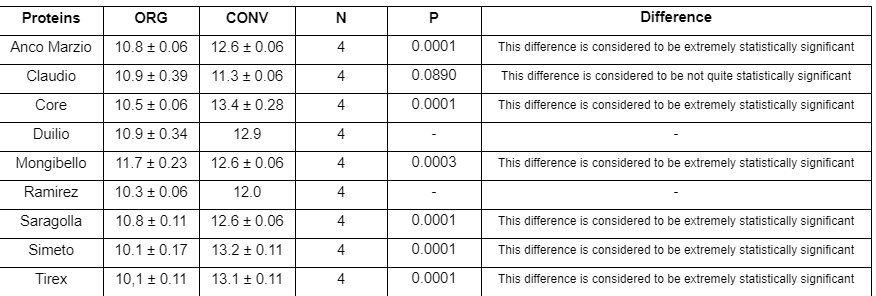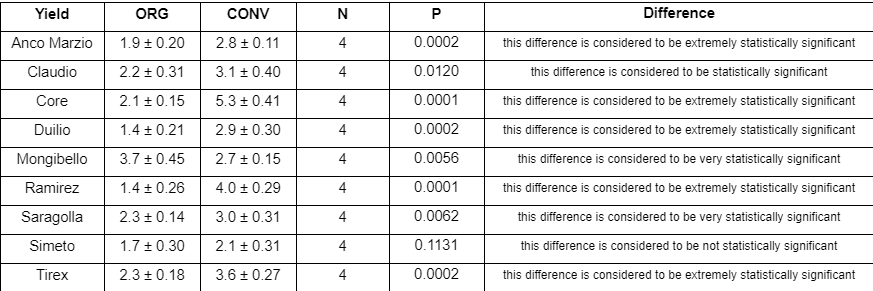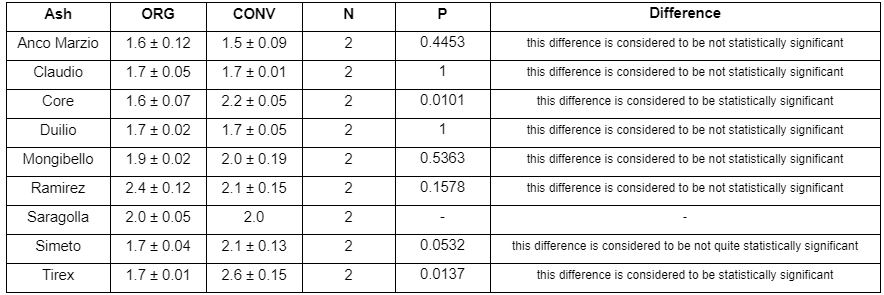Wheat ranks fourth on FAO's list of top 50 commodities. The Durum wheat accounts for about 8% of total world wheat production.
According to Pandino et al (2020) They analized different chemical and phisycal propierties and they found 4 cultivares of wheat fruit to be different if they are grown on ecological conditions or in convencional conditions.

The wheat cultivar of Simeto in organic conditions proteins is 10.1 ± 0.17 % DM (Dry matter) and in coventional conditions is 13.2 ± 0.11 % DM (Dry matter). The autors p= < 0,05, and i calculate student T test is knowing N=4. Using the previous data in the website Graphpad Students T test online the calculated p < 0,0001.
The wheat cultivar proteins of Mongibello in organic conditions is 11.7 ± 0.23 and under conventional conditions it is 12.6 ± 0.06. The authors p= < 0.05, and the calculation of the student's t-test is knowing N=4. Graphpad Students T test online the calculated p < 0.0003 where there are differences.
The wheat cultivar wet gluten of Simeto in organic conditions is 22.0 ± 0.92 % and in coventional conditions is 36.6 ± 0.32 %. The autors p= < 0,05, and i calculate student T test is knowing N=4. Graphpad Students T test online the calculated p < 0,0001 where there are differences.
The wheat cultivar wet gluten of Duilio wheat in organic conditions is 28.8 ± 3.04 and under conventional conditions it is 31.3 ± 0.67. The authors p= < 0.05, and the calculation of the student's t-test is knowing N=4. Graphpad Students T test online the calculated p < 0.1594.
The wheat cultivar yield of simeto in organic conditions is 1.7 ± 0.30 and in coventional conditions is 2.1 ± 0.31. The autors p= < 0,05, and i calculate student T test is knowing N=4. Graphpad Students T test online the calculated p < 0.1131 where there is no difference.
With these comparisons we can say that there is no correlation between wet gluten and protein as there are differences.

The wheat cultivar ash of Ramirez in organic conditions is 2.4 ± 0.12 and under conventional conditions is 2.1 ± 0.15. The authors p= < 0.05, and the calculation of the student's t-test is knowing N=2. Graphpad Students T test online the calculated p < 0.1578 where there is no difference.
The wheat cultivar ash of Tirex in organic conditions is 1.7 ± 0.01 and under conventional conditions is 2.6 ± 0.15. The authors p= < 0.05, and the calculation of the students' t-test is know N=2. The t-test of Graphpad students online the calculated p < 0.0137 where there is a difference.
The wheat cultivar K of Duilio in organic conditions is 5240 ± 268.7 and under conventional conditions is 5161 ± 139.5. The authors p= < 0.05, and the calculation of the students' t-test is know N=2. The t-test of Graphpad students online the calculated p < 0.7475 where there is no difference.
The wheat cultivar K of Claudio in organic conditions is 3594 ± 205.3 and under conventional conditions is 5268 ± 380.8. The authors p= < 0.05, and the calculation of the students' t-test is know N=2. The t-test of Graphpad students online the calculated p < 0.0318 donde sí hay diferencia.
The wheat cultivar Na of Mongibello in organic conditions is 79 ± 2.2 and under conventional conditions is 74 ± 1.4 . The authors p= < 0.05, and the calculation of the students' t-test is know N=2. The t-test of Graphpad students online the calculated p < 0.1133 where there is no difference.
The wheat cultivar Na of Simeto in organic conditions is 75 ± 2.9 and under conventional conditions is 77 ± 2.3 . The authors p= < 0.05, and the calculation of the students' t-test is know N=2. The t-test of Graphpad students online the calculated p < 0.5246 where there is no difference.
Correction
In this research, we took all the means and did the t-test in Graphpad, a program to calculate the student t and compare with the p. That's how we got all the comparisons of the t with the p of the nutrients and elements shown in the file.






We start with proteins, where we can see the difference between organic and conventional farming. The section on the differences that we investigated, they tell us that there are differences, but they are not that significant. They tell us that the conventional crop has the most protein and the organic crop has the least. This is due to the climate, an increase in temperatures induced a lower concentration of protein in the grains that you see in the table. With wet gluten and yield, we also observe that there are not so many differences, but conventional gluten has the most of these points. Liquid gluten, which represents the physico-chemical properties of gluten, as well as the gluten index. Finally there are the minerals, where we investigated that the difference is not very significant, but still there is, and organic cultivation takes it. This is due to the method of cultivation and the extraction of minerals that organic cultivation has, while conventional cultivation does not have this characteristic. However, we cannot say that the conventional cultivation does not have minerals. Although it is less than the organic one, the difference between the two crops is not significant, so we could say that they are almost the same.
In conclusion, the conventional cultivation method is the one that has more properties compared to organic cultivation.
Author.- G Pandino et al - Dipartimento di Agricoltura, Alimentazione e Ambiente (Di3A), Universidad de Catania - Italia - 22 January 2020
Research